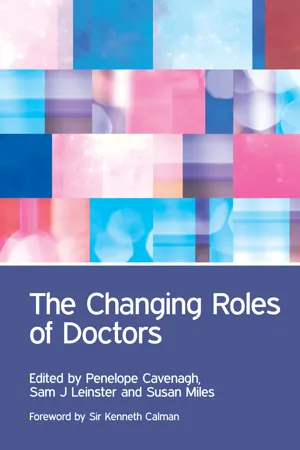
The Changing Roles of Doctors
Penny Cavenagh, Sam Leinster, Veena Rodrigues, Mick Collins, Susanne Lindqvist, Ann Barrett, Andrea Stockl, Amanda Howe, Alistair Leinster
- 168 pages
- English
- ePUB (mobile friendly)
- Available on iOS & Android
The Changing Roles of Doctors
Penny Cavenagh, Sam Leinster, Veena Rodrigues, Mick Collins, Susanne Lindqvist, Ann Barrett, Andrea Stockl, Amanda Howe, Alistair Leinster
About This Book
This fascinating new book describes the evolution of the medical profession and how the role of the doctor and expectations of that role have changed over time. It critically examines developments in the light of both external influences such as the ageing population, patient attitudes and knowledge and government regulation, and internal changes such as the increasing knowledge base, advances in technology and changes in recruitment. Challenges in management, working environment, education and training are considered and practical recommendations for both practising and student doctors are offered. The holistic approach is supported with contributions from both primary and secondary care practitioners together with academics and educationalists. It is highly recommended for doctors and medical students seeking new strategies for understanding and managing change. Sociologists and policy makers, too, will find the wide-ranging perspectives enlightening.
Frequently asked questions
Information
List of contributors
CHAPTER 1 Drivers for change in the medical profession
INTRODUCTION
FROM CARE TO CURE
FROM INDEPENDENT GUILD TO REGULATED PROFESSION
Table of contents
- Cover
- Title
- Copyright
- Contents
- Foreword
- About the editors
- List of contributors
- Index